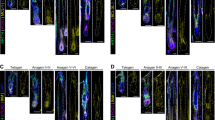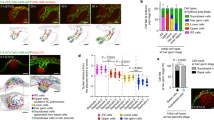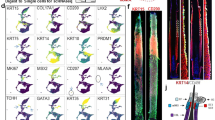Abstract
Overexpression of the TCL1 gene family plays a role in the onset of T-cell leukemias in mice and in humans. The Tcl1 gene is tightly regulated during early embryogenesis in which it participates in embryonic stem (ES)-cells proliferation and during lymphoid differentiation. Here, we provide evidences that Tcl1 is also important in mouse hair follicle (HF) and skin homeostasis. We found that Tcl1−/− adult mice exhibit hair loss, leading to alopecia with extensive skin lesions. By analysing Tcl1 expression in the wild-type (wt) skin through different stages of hair differentiation, we observe high levels in the secondary hair germ (HG) cells and hair bulges, during early anagen and catagen–telogen transition phases. The loss of Tcl1 does not result in apparent skin morphological defects during embryonic development and at birth, but its absence causes a reduction of proliferation in anagen HFs. Importantly, we show the that absence of Tcl1 induces a significant loss of the stem-cell marker CD34 (but not α6-integrin) expression in the bulge cells, which is necessary to maintain stem-cell characteristics. Therefore, our findings indicate that Tcl1 gene(s) might have important roles in hair formation, by its involvement in cycling and self-renewal of transient amplifying (TA) and stem-cell (SC) populations.
This is a preview of subscription content, access via your institution
Access options
Subscribe to this journal
Receive 50 print issues and online access
$259.00 per year
only $5.18 per issue
Buy this article
- Purchase on SpringerLink
- Instant access to full article PDF
Prices may be subject to local taxes which are calculated during checkout





Similar content being viewed by others
Abbreviations
- HF:
-
hair follicle
- ORS:
-
outer root sheath
- SC:
-
stem cells
- TA:
-
transient amplifying
- TCL1 :
-
T-cell leukemia/lymphoma 1
References
Bichi R, Shinton SA, Martin ES, Koval A, Calin GA, Cesari R et al. (2002). Human chronic lymphocytic leukemia modeled in mouse by targeted TCL1 expression. Proc Natl Acad Sci USA 99: 6955–6960.
Blanpain C, Lowry WE, Geoghegan A, Polak L, Fuchs E . (2004). Self-renewal, multipotency, and the existence of two cell populations within an epithelial stem cell niche. Cell 118: 635–648.
Chase HB . (1954). Growth of the hair. Physiol Rev 34: 113–126.
Cotsarelis G, Sun TT, Lavker RM . (1990). Label-retaining cells reside in the bulge area of pilosebaceous unit: implications for follicular stem cells, hair cycle, and skin carcinogenesis. Cell 61: 1329–1337.
Ema M, Mori D, Niwa H, Hasegawa Y, Yamanaka Y, Hitoshi S et al. (2008). Krüppel-like factor 5 is essential for blastocyst development and the normal self-renewal of mouse ESCs. Cell Stem Cell 3: 555–567.
Di-Poï N, Ng CY, Tan NS, Yang Z, Hemmings BA, Desvergne B et al. (2005). Epithelium-mesenchyme interactions control the activity of peroxisome proliferator-activated receptor β/δ™ during hair follicle development. Mol Cell Biol 25: 1696–1712.
French SW, Dawson DW, Chen HW, Rainey RN, Sievers SA, Balatoni CE et al. (2006). The TCL1 oncoprotein binds the RNase PH domains of the PNPase exoribonuclease without affecting its RNA degrading activity. Cancer Lett 248: 198–210.
Galan-Caritad JM, Harel S, Arenzana TL, Hou E, Doetsch FK, Mirny AL et al. (2007). Zfx controls the self-renewal of embryonic and hematopoietic stem cells. Cell 129: 345–357.
Glover CH, Marin M, Eaves CJ, Helgason CD, Piret JM, Bryan J. . (2006). Meta-analysis of differentiating mouse embryonic stem cell gene expression kinetics reveals early change of a small gene set. PLoS Comput Biol 2: e158.
Hallas C, Pekarsky Y, Itoyama T, Varnum J, Bichi R, Rothstein JL et al. (1999). Genomic analysis of human and mouse TCL1 loci reveals a complex of tightly clustered genes. Proc Natl Acad Sci USA 96: 14418–14423.
Hoyer KK, French SW, Turner DE, Nguyen MT, Renard M, Malone CS et al. (2002). Dysregulated TCL1 promotes multiple classes of mature B cell lymphoma. Proc Natl Acad Sci USA 99: 14392–14397.
Ito M, Kizawa K, Hamada K, Cotsarelis G . (2004). Hair follicle stem cells in the lower bulge form the secondary germ, a biochemically distinct but functionally equivalent progenitor cell population, at the termination of catagen. Differentiation 72: 548–557.
Ito M, Liu Y, Yang Z, Nguien J, Liang F, Morris RJ et al. (2005). Stem cells in the hair follicle bulge contribute to wound repair but not to homeostasis of the epidermis. Nat Med 11: 1351–1354.
Ivanova N, Dobrin R, Lu R, Kotenko I, Levorse J et al. (2006). Dissecting self-renewal in stem cells with RNA interference. Nature 442: 533–538.
Kang SM, Narducci MG, Lazzeri C, Mongiovì MA, Caprini E, Bresin A et al. (2005). Impaired T- and B-cell development in Tcl1-deficient mice. Blood 105: 1288–1294.
Kunstle G, Laine J, Pierron G, Kagami Si S, Nakajima H, Hoh F et al. (2002). Identification of Akt association and oligomerization domains of the Akt kinase coactivator TCL1. Mol Cell Biol 22: 1513–1525.
Laine J, Kunstle G, Obata T, Sha M, Noguchi M . (2000). The protooncogene TCL1 is an Akt kinase coactivator. Mol Cell 6: 395–407.
Laine J, Kunstle G, Obata T, Noguchi M . (2002). Differential regulation of Akt kinase isoforms by the members of the TCL1 oncogene family. J Biol Chem 277: 3743–3751.
Matoba R, Niwa H, Masui S, Ohtsuka S, Carter MG, Sharov AA et al. (2006). Dissecting Oct3/4-regulated gene networks in embryonic stem cells by expression profiling. PLoS ONE 1: e26.
Morris RJ, Potten CS . (1999). Highly persistent label-retaining cells in the hair follicles of mice and their fate following induction of anagen. J Invest Dermatol 112: 470–475.
Murayama K, Kimura T, Tarutani M, Tomooka M, Hayashi R, Okabe M et al. (2007). Akt activation induces epidermal hyperplasia and proliferation of epidermal progenitors. Oncogene 26: 4882–4888.
Muller-Rover S, Handjiski B, van der Veen C, Eichmuller S, Foitzik K, McKay IA et al. (2001). A comprehensive guide for the accurate classification of murine hair follicles in distinct hair cycle stages. J Invest Dermatol 117: 3–15.
Narducci MG, Stoppacciaro A, Imada K, Uchiyama T, Virgilio L, Lazzeri C et al. (1997a). TCL1 is overexpressed in patients affected by adult T-cell leukemias. Cancer Res 57: 5452–5456.
Narducci MG, Virgilio L, Engiles JB, Buchberg AM, Billips L, Facchiano A et al. (1997b). The murine Tcl1 oncogene: embryonic and lymphoid cell expression. Oncogene 15: 919–926.
Narducci MG, Pescarmona E, Lazzeri C, Signoretti S, Lavinia AM, Remotti D et al. (2000). Regulation of TCL1 expression in B- and T-cell lymphomas and reactive lymphoid tissues. Cancer Res. 60: 2095–2100.
Narducci MG, Fiorenza MT, Kang SM, Bevilacqua A, Di Giacomo M, Remotti D et al. (2002). TCL1 participates in early embryonic development and is overexpressed in human seminomas. Proc Natl Acad Sci USA 99: 11712–11717.
Panteleyev AA, Paus R, Christiano AM . (2000). Patterns of hairless (hr) gene expression in mouse hair follicle morphogenesis and cycling. Am J Pathol 157: 1071–1079.
Panteleyev AA, Jahoda CA, Christiano AM . (2001). Hair follicle predetermination. J Cell Sci 114: 3419–3431.
Paus R, Stenn KS, Link RE . (1990). Telogen skin contains an inhibitor of hair growth. Br J Dermatol 122: 777–784.
Paus R, Eichmuller S, Hofmann U, Czarnetzki BM, Robinson P . (1994a). Expression of classical and non-classical MHC class I antigens in murine hair follicles. Br J Dermatol 131: 177–183.
Paus R, Handjiski B, Czarnetzki BM, Eichmuller S . (1994b). A murine model for inducing and manipulating hair follicle regression (catagen): effects of dexamethasone and cyclosporin A. J Invest Dermatol 103: 143–147.
Paus R, Muller-Rover S, van der Veen C, Maurer M, Eichmuller S, Ling G et al. (1999). A comprehensive guide for the recognition and classification of distinct stages of hair follicle morphogenesis. J Invest Dermatol 113: 523–532.
Pekarsky Y, Koval A, Hallas C, Bichi R, Tresini M, Malstrom S et al. (2000). Tcl1 enhances Akt kinase activity and mediates its nuclear translocation. Proc Natl Acad Sci USA 97: 3028–3033.
Peng X, Xu P-Z, Chen M-L, Hahn-Windgassen A, Skeen J, Jacobs J et al. (2003). Dwarfism, impaired skin development, skeletal muscle atrophy, delayed bone development, and impeded adipogenesis inn mice lacking Akt1 and Akt2. Genes Dev 17: 1352–1365.
Russo G, Isobe M, Pegoraro L, Finan J, Nowell PC, Croce CM . (1988). Molecular analysis of a t(7;14)(q35;q32) chromosome translocation in a T cell leukemia of a patient with ataxia telangiectasia. Cell 53: 137–144.
Stenn KS, Paus R . (2001). Controls of hair follicle cycling. Physiol Rev 81: 449–494.
Takizawa J, Suzuki R, Kuroda H, Utsunomiya A, Kagami Y, Joh T et al. (1998). Expression of the TCL1 gene at 14q32 in B-cell malignancies but not in adult T-cell leukemia. Jpn J Cancer Res 89: 712–718.
Teitell M, Damore MA, Sulur GG, Turner DE, Stern MH, Said JW et al. (1999). TCL1 oncogene expression in AIDS-related lymphomas and lymphoid tissues. Proc Natl Acad Sci USA 96: 9809–9814.
Tiede S, Kloepper JE, Bodò E, Tiwari S, Kruse C, Paus R . (2007). Hair follicle stem cells: walking the maze. Eur J Cell Biol 86: 355–376.
Trempus CS, Morris RJ, Ehinger M, Elmore A, Bortner CD, Ito M et al. (2007). CD34 expression by hair follicle stem cells is required for skin tumor development in mice. Cancer Res 67: 4173–4181.
Tumbar T, Guasch G, Greco V, Blanpain C, Lowry W E, Rendl M et al. (2004). Defining the epitelial stem cell niche in the skin. Science 303: 359–363.
Virgilio L, Narducci MG, Isobe M, Billips LG, Cooper MD, Croce CM et al. (1994). Identification of the TCL1 gene involved in T-cell malignancies. Proc Natl Acad Sci USA 91: 12530–12534.
Virgilio L, Lazzeri C, Bichi R, Nibu K, Narducci MG, Russo G et al. (1998). Deregulated expression of TCL1 causes T cell leukemia in mice. Proc Natl Acad Sci USA 95: 3885–3889.
Yang Z-Z, Tschopp O, Di-Poï N, Bruder E, Baudry A, Dümmler B et al. (2005). Dosage-dependent effects of Akt1/protein kinase Bα (PKBα) and Akt3/PKBγ on thymus, skin, and cardiovascular and nervous system development in mice. Mol Cell Biol 25: 10407–10418.
Yu H, Fang D, Kumar SM, Li L, Nguyen TK et al. (2006). Isolation of a novel population of multipotent adult stem cells from human hair follicles. Am J Path 168: 1879–1888.
Zanesi N, Aqeilan R, Drusco A, Kaou M, Sevignani C, Costinean S et al. (2006). Effect of rapamycin on mouse chronic lymphocytic leukemia and the development of nonhematopoietic malignancies in Eu-TCL1 transgenic mice. Cancer Res 66: 915–920.
Acknowledgements
We thank M Helmer Citterich and Paolo Fadda for technical assistance, sequencing and microarrays services and Dr G Zambruno for helpful comments during the preparation of the paper. This work was supported by grants from the Associazione Italiana Ricerca sul Cancro (AIRC) and from the Ministero della Sanità.
Author information
Authors and Affiliations
Corresponding author
Additional information
Conflict of interest
The authors declare no conflict of interest
Supplementary Information accompanies the paper on the Oncogene website (http://www.nature.com/onc)
Supplementary information
Rights and permissions
About this article
Cite this article
Ragone, G., Bresin, A., Piermarini, F. et al. The Tcl1 oncogene defines secondary hair germ cells differentiation at catagen–telogen transition and affects stem-cell marker CD34 expression. Oncogene 28, 1329–1338 (2009). https://doi.org/10.1038/onc.2008.489
Received:
Revised:
Accepted:
Published:
Issue date:
DOI: https://doi.org/10.1038/onc.2008.489



